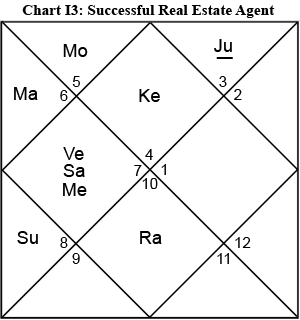| Free Jyotish Newsletter |
 Jyotish.ws
Jyotish.wsHome Sweet Home: How to Look for Real Estate in a Chart
| By Deborah Allison |  |
The four pillars of the horoscope in terms of relative life are said to be the 1st, 4th, 7th and 10th bhavas. The 1st bhava is the basis of the entire chart. For a person to utilize what is in the chart, the 1st bhava and its lord should be strong. The 4th bhava represents many themes that anchor the foundations of life as well. Sage Parashara tells us to examine the 4th house and its lords for conveyances, ancestors and current relatives, mother, happiness, treasure, lands and houses. These kinds of significations are repeated across many shastras. According to the second principle of exegesis known as abhyasa or repetition (see The Path into Shastra Part III: Repetition Makes Perfect from the June/July 2007 edition of this newsletter) this gives us the assurance that this is not an idiosyncratic reference and we may rely on this bhava as the principle seat for assessing property.
As with all methods of analysis, the trick is to see an indication repeated in several different ways before we can count on it as a major indicator of someone's destiny pattern. Therefore, along with the 4th bhava and its lord, shastra directs us to look at two grahas in particular, Mars and Saturn. These planets are the karakas or signifiers for property. The "official" name for these grahas is bhumi karakas where again the root bhu is the source of the derivation of the word. However, this time, it signifies a more metaphoric idea of "being" as the ground state of what supports everything on earth: the land. "Under all is the land. Upon its wise utilization and widely allocated ownership depend the survival and growth of free institutions and of our civilization." This quote is the basis of the National Association of Realtors charter and is quite a beautiful statement for the importance of land and property in all cultures at all times.
In addition to the main chart, there is a particular divisional chart that can be assessed for matters of land and property. Though shastras gives very little specific information on the utility of each of the divisional charts, the tradition uses the fourth divisional chart known as the Turyamsha or Chaturtamsha for assessing large fixed assets such as property.
Putting together some of the pieces from above, we may surmise that certain chart configurations may be "giveaways" in terms of a predilection toward property. For example, a Capricorn ascendant (owned by Saturn, a bhumi karaka) could have an exalted Mars in the ascendant. That Mars would aspect into its own 4th bhava of Aries. Or Mars could simply be in its own 4th bhava. This would incline towards property with both bhumi karakas active, though Saturn is more of a passive indicator as the lord of the chart and Mars the active indicator. However, paradoxically, it is also true that Saturn, the lord of the Capricorn ascendant, is debilitated in the sign of Aries which falls on the 4th bhava. Therefore, though property is very important to such a person, there is also a chronic dissatisfaction in the matter of property.
Either a Gemini or Sagittarius chart with the fourth lord in the ascendant will give a powerful boost to the theme of property. In the case of the Gemini chart, Mercury will own the 4th bhava as it rules the sign of Virgo and if it is in its own Gemini 1st house, it will be doubly strong as it is swa rashi or own sign as well as having directional strength. The same is true of Jupiter for the Sagittarius ascendant. The 4th bhava will be a Pisces 4th bhava, Jupiter's other sign and it too will be in its own sign in the lagna as lord of the fourth with directional strength and therefore doubly strong. You can also have it the other way around. Mercury as lord of a Gemini lagna could be in Virgo in its own 4th bhava and once again, a very powerful indicator of the linkage between self and property. The parallel structure could occur for the Sagittarius ascendant.
When the lord of someone's 4th house is in a dussthana and afflicted, if there is confluence from other indications, the person may suffer on account of their property. For example, a debilitated Saturn as the lord of the 4th bhava in the 6th can indicate expenses from real estate that are anxiety provoking (Saturn) or can indicate debt taken on to resolve issues around the property that might be caused by basement problems (Saturn). The combinations are endless, which is one of the reasons Jyotisha is endlessly fascinating.
One other important indicator that plays out for many people is moving from one's home or apartment. The 12th bhava represents "loss" in a very general sense. If the lord of the 4th bhava or a dasha lord is placed in the 3rd bhava, it is in fact twelve bhavas away from the fourth counting in a counter-clockwise inclusive direction. The third house therefore represents the "loss of" what the 4th house stands for and that can be one's home, land etc. This does not have to be a negative situation at all. It can simply represent a move. If there is affliction and weakness, the move may be stressful or disadvantageous but the opposite can be true if the person has a good 4th house and a good 4th divisional chart at the time of the move. They might have sold their property for a profit and are moving, so to speak, up in life.
Let us look at a few examples to illustrate these principles further.
 Chart I3 is a classic example of
someone who
may do very well in terms of real estate. Note that
there are two very powerful grahas in the 4th bhava.
Venus is the lord of the fourth in the fourth and Venus
also has directional strength in that angle, making it
doubly strong. Venus on its own forms a Malavya
Yoga—one of the five panchamahapurusha
yogas.
Saturn (bhumi karaka) is exalted in the 4th and since
an exalted graha is always subject to the strength of
its landlord, this is a supremely well-placed Saturn
with the landlord Venus doubly strong and living in the
same house. The whole combination is aspected by
a strong Jupiter, and Mercury joins the household as
the third roommate. It so happens that in the
planetary community, Mercury, Venus and Saturn are
all friends so this is a very harmonious and happy
household. The Sasha Yoga that Saturn forms, being
exalted in an angle, is as good as it gets because
Saturn is totally stabilized by benefics without a
malefic in sight. This person is a very prominent real
estate agent and owns some nice property in a very
upscale community in California.
Chart I3 is a classic example of
someone who
may do very well in terms of real estate. Note that
there are two very powerful grahas in the 4th bhava.
Venus is the lord of the fourth in the fourth and Venus
also has directional strength in that angle, making it
doubly strong. Venus on its own forms a Malavya
Yoga—one of the five panchamahapurusha
yogas.
Saturn (bhumi karaka) is exalted in the 4th and since
an exalted graha is always subject to the strength of
its landlord, this is a supremely well-placed Saturn
with the landlord Venus doubly strong and living in the
same house. The whole combination is aspected by
a strong Jupiter, and Mercury joins the household as
the third roommate. It so happens that in the
planetary community, Mercury, Venus and Saturn are
all friends so this is a very harmonious and happy
household. The Sasha Yoga that Saturn forms, being
exalted in an angle, is as good as it gets because
Saturn is totally stabilized by benefics without a
malefic in sight. This person is a very prominent real
estate agent and owns some nice property in a very
upscale community in California.
 At first glance, one
might think there would be a
problem in
Chart I4 with 4th house matters
because
Mars is debilitated in the 4th house and in the Rahu
Ketu axis. However, in Jyotisha, it is an established
principle that analysis of yogas indicates how far
above or below the baseline a person is operating.
The principles of bhava analysis tell us more of the
details of that experience once the chart is
contextualized. In this chart, the exalted Jupiter keys a
number of major yogas that indicate wealth and
preeminence with respect to land. One of those is the
yoga involving the bhumi karaka Mars as the lord of
the first house with Jupiter, the lord of the 9th house
of good fortune. Since Jupiter is so powerful as the 9th
lord, this is a fully accountable yoga, especially if
Jupiter is activated by its dasha running. Mars also
participates in a Chandra Mangala yoga with Moon as
the fourth lord and therefore also representing real
estate. It looks back to its own bhava and is
stabilized by that same powerful Jupiter with which it
also forms two more powerful yogas. This is the chart
of George Lucas. Obviously he got his money from
other sources as well but it is perhaps not a
well-known fact that he owns huge acreage in Marin
County which is worth untold millions at this point in
time. The Star Wars venture happened in his
Rahu and Jupiter dashas. Rahu being joined with
Jupiter and "party" to all those yogas will give the
results of them all. Skywalker Ranch was the
headquarters for the filming, animation,
etc.—the heart
of the Lucas enterprise—and remains a
disproportionate amount of the Lucas portfolio of
wealth.
At first glance, one
might think there would be a
problem in
Chart I4 with 4th house matters
because
Mars is debilitated in the 4th house and in the Rahu
Ketu axis. However, in Jyotisha, it is an established
principle that analysis of yogas indicates how far
above or below the baseline a person is operating.
The principles of bhava analysis tell us more of the
details of that experience once the chart is
contextualized. In this chart, the exalted Jupiter keys a
number of major yogas that indicate wealth and
preeminence with respect to land. One of those is the
yoga involving the bhumi karaka Mars as the lord of
the first house with Jupiter, the lord of the 9th house
of good fortune. Since Jupiter is so powerful as the 9th
lord, this is a fully accountable yoga, especially if
Jupiter is activated by its dasha running. Mars also
participates in a Chandra Mangala yoga with Moon as
the fourth lord and therefore also representing real
estate. It looks back to its own bhava and is
stabilized by that same powerful Jupiter with which it
also forms two more powerful yogas. This is the chart
of George Lucas. Obviously he got his money from
other sources as well but it is perhaps not a
well-known fact that he owns huge acreage in Marin
County which is worth untold millions at this point in
time. The Star Wars venture happened in his
Rahu and Jupiter dashas. Rahu being joined with
Jupiter and "party" to all those yogas will give the
results of them all. Skywalker Ranch was the
headquarters for the filming, animation,
etc.—the heart
of the Lucas enterprise—and remains a
disproportionate amount of the Lucas portfolio of
wealth.
 Chart I5 is the chart of a
business executive
named Al Checchi who joined the Marriot Hotel group
at the height of the real estate recession of the late
1970's and engineered seven years of huge corporate
growth. He also was a principal in Northwest Airlines
through acquisition of its parent company. Although
we did not discuss it in this article, conveyances such
as cars, boats, airplanes are also a 4th bhava matter.
In this chart, note the spectacular Jupiter with triple
strength in the ascendant (own house, directional
strength and retrogression) fully stabilized by a
powerful Venus (retrograde) and Mercury in its own
rashi. Wow! What an amazing 1/7 axis! His real
estate ventures got underway in his Jupiter dasha
which ran at the prime of life from about 30 to 46 years
old. Jupiter is the lord of the 4th bhava of real
estate—
totally empowered and dominant in the life of this
person. It is poised to give money through several of
the gorgeous raja and dhana yogas across the 1/7
axis.
Chart I5 is the chart of a
business executive
named Al Checchi who joined the Marriot Hotel group
at the height of the real estate recession of the late
1970's and engineered seven years of huge corporate
growth. He also was a principal in Northwest Airlines
through acquisition of its parent company. Although
we did not discuss it in this article, conveyances such
as cars, boats, airplanes are also a 4th bhava matter.
In this chart, note the spectacular Jupiter with triple
strength in the ascendant (own house, directional
strength and retrogression) fully stabilized by a
powerful Venus (retrograde) and Mercury in its own
rashi. Wow! What an amazing 1/7 axis! His real
estate ventures got underway in his Jupiter dasha
which ran at the prime of life from about 30 to 46 years
old. Jupiter is the lord of the 4th bhava of real
estate—
totally empowered and dominant in the life of this
person. It is poised to give money through several of
the gorgeous raja and dhana yogas across the 1/7
axis.
We could touch on timing of the acquisition of a property, dividing up property among siblings as part of estate settlements, land development, the building trades, interior decorating, mining, oil exploration and countless other ventures all under the jurisdiction of the 4th bhava. The texture of a chart is so very rich that we could go on endlessly examining this one theme of real estate—an important 4th bhava matter—but just one of many. Jyotisha is a truly amazing and magnificent lens through which to examine any microscopic portion of human life.
(c) copyright 2007 Michael Laughrin.
From the August/September, 2007 issue of Michael Laughrin's North American Jyotish
Newsletter. Click to subscribe to this free Jyotish newsletter.
Read more articles.